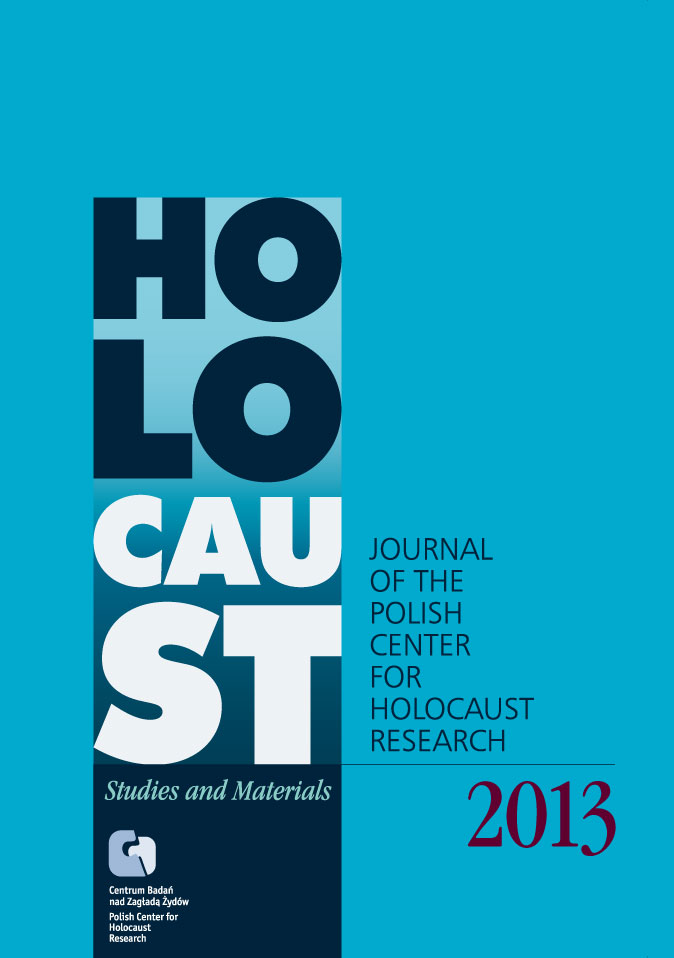Gone but not Forgotten: Archaeological approaches to the site of the former Treblinka Extermination Camp in Poland
Zagłada Żydów. Studia i Materiały, Nr Holocaust Studies and Materials (2013), Strony: 253-289
Data zgłoszenia: 2020-12-13Data publikacji: 2013-02-20
 https://doi.org/10.32927/zzsim.809
https://doi.org/10.32927/zzsim.809
Abstrakt
Public impression of the Holocaust is unquestionably centred on knowledge about, and the image of, Auschwitz-Birkenau – the gas chambers, the crematoria, the systematic and industrialized killing of victims. Conversely, knowledge of the former extermination camp at Treblinka, which stands in stark contrast in terms of the visible evidence that survives pertaining to it, is less embedded in general public consciousness. As this paper argues, the contrasting level of knowledge about Auschwitz-Birkenau and Treblinka is centred upon the belief that physical evidence of the camps only survives when it is visible and above-ground. The perception of Treblinka as having been “destroyed” by the Nazis, and the belief that the bodies of all of the victims were cremated without trace, has resulted in a lack of investigation aimed at answering questions about the extent and nature of the camp, and the locations of mass graves and cremation pits. This paper discusses the evidence that demonstrates that traces of the camp do survive. It outlines how archival research and non-invasive archaeological survey has been used to re-evaluate the physical evidence pertaining to Treblinka in a way that respects Jewish Halacha Law. As well as facilitating spatial and temporal analysis of the former extermination camp, this survey has also revealed information about the cultural memory associated with the site and how much has been forgotten about its history.
Licencja
Prawa autorskie (c) 2013 Autor & "Zagłada Żydów. Studia i Materiały"

Utwór dostępny jest na licencji Creative Commons Uznanie autorstwa 4.0 Międzynarodowe.
https://creativecommons.org/licenses/by/4.0
Inne teksty tego samego autora
- Caroline Sturdy Colls, O tym, co minęło, lecz nie zostało zapomniane: Badania archeologiczne na terenie byłego obozu zagłady w Treblince , Zagłada Żydów. Studia i Materiały: Nr 8 (2012)
Podobne artykuły
- Tomasz Żukowski, Polemika z recenzją Bartłomieja Krupy [Tomasz Żukowski] , Zagłada Żydów. Studia i Materiały: Nr 17 (2021)
- Dagmara Swałtek, Gusta Ehrlich’s Letters , Zagłada Żydów. Studia i Materiały: 2010: Holocaust Studies and Materials
- Marek Kornat, Papież Pius XII i jego koncepcja „neutralności absolutnej” Stolicy Apostolskiej w stosunkach międzynarodowych (1939—1945). Przypadek Polski , Zagłada Żydów. Studia i Materiały: Nr 5 (2009)
- Ewa Mork, Otwarcie Norweskiego Centrum Badań nad Zagładą w Oslo , Zagłada Żydów. Studia i Materiały: Nr 3 (2007)
- Ewa Mork, Omówienia najnowszej literatury na temat Zagłady Żydów: Skandynavia , Zagłada Żydów. Studia i Materiały: Nr 3 (2007)
- Anna Bikont, Nasza polska gorączka złota: Paweł Piotr Reszka, Płuczki [Anna Bikont] , Zagłada Żydów. Studia i Materiały: Nr 17 (2021)
- Jan Grabowski, Doris Tausendfreund, Erzwungener Verrat. Jüdische “Greifer” im Dienst der Gestapo, 1943-1945 , Zagłada Żydów. Studia i Materiały: Nr 4 (2008)
- Redakcja, Od redakcji , Zagłada Żydów. Studia i Materiały: Nr 15 (2019)
- Piotr Filipkowski, Piotr M.A. Cywiński, Auschwitz. Monografia Człowieka [Piotr Filipkowski] , Zagłada Żydów. Studia i Materiały: Nr 17 (2021)
- Redakcja, Od Redakcji , Zagłada Żydów. Studia i Materiały: Nr 3 (2007)
<< < 32 33 34 35 36 37 38 39 40 41 42 43 44 45 46 47 48 49 50 51 52 53 54 55 56 57 58 59 60 61 62 63 64 65 66 67 68 69 70 71 > >>
Możesz również Rozpocznij zaawansowane wyszukiwanie podobieństw dla tego artykułu.
 English
English
 Język Polski
Język Polski








